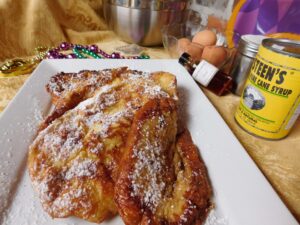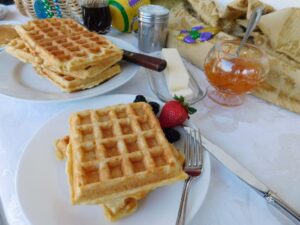Eating Oxford
On Cooking Southern: Breakfast-For-Supper Shines Beyond Shrove Tuesday
SOUTHERNISM OF THE WEEK
Come-to-Jesus meeting: A confrontation in which the Truth shall be revealed, pleasant or not, comfortable to hear, or not … the meet-ee is gonna hear facts from the meet-or that need to be clarified and embraced.
Did I blink too fast?
Mardi Gras came early this year. Fat Tuesday has been and gone already.
Churches all over Lafayette County honored tradition this year on February 9 with communal Fat Tuesday pancake suppers. Now it’s time for folks to get serious and dial back the party-related gluttony. This worldwide practice among Christians transcends ethnicity and dates back to early Christian times. Some scholars believe the practice may even predate Christianity — referencing ancient Slavic pagan pancake events dedicated to fighting off Winter and urging in Spring
Nevertheless, Christians worldwide have embraced the pancake on a special date nicknamed Fat Tuesday. The official name is Shrove Tuesday. The word “shrove” is the Latin past tense for the word shrive, which means “to hear a confession, assign penance, and absolve from sin.”
Shrove Tuesday always falls the day before Ash Wednesday, 47 days before Easter. It marks the start of the Lenten season during which Christians give up luxuries in remembrance of Jesus’ 40 days in the wilderness. Traditionally, such luxuries included good food, which meant meat and animal products such as fat, eggs, cheese and butter.
Over time, Fat Tuesday became the ultimate feast date called Mardi Gras, the French term that literally means Fat Tuesday. It also is known as Carnivale, various Romance languages’ literal word for “farewell to meat.” It evolved into the day for Christians to feast on foods cleaned out of the pantry in anticipation of the season of fasting.
Times have changed a bit over the centuries. Most Christian groups that observe Lent no longer require strict food abstinence for 40 days. But Roman Catholics, Eastern Orthodox, Anglicans, Lutherans, Methodists, Calvinists and some evangelical denominations still observe Lenten abstinence by holding pancake suppers on Fat Tuesday before fasting on Ash Wednesday and Good Friday.
The event, the season and the times remind The Old Bride that nothing beats preparing and sharing breakfast foods for suppertime communal gatherings. By their very nature, breakfast fixings such as pancakes, waffles and French toast demand informality and collective participation of those gathered for the meal. Throw in fried treats such as the old-fashioned Creole cala, and add some fruit and bacon, and the supper will be fit for a King.
BREAK OUT THE GRIDDLE, WAFFLE IRON AND DEEP FRYER FOR PANCAKES, FRENCH TOAST, WAFFLES AND CALAS
It’s about as easy to prepare scratch pancakes as it is to work from packaged mixes. French toast cooks up as easily as scrambled eggs. And the rice waffles shared here are an interesting departure from the usual oil-based flour versions with which most of us are familiar.
There are a few tricks to successful pancake and waffle griddling. The batters must not be over-beaten and must be rested for a time to encourage the leavening process. The griddle or waffle iron surface must be clean and preheated for maximum heat. Test them for proper heat by dropping a few drops of water onto the surface; if they bounce, the griddle or waffle iron is properly seasoned and hot enough. If the droplets dissipate, it’s time to lightly brush with oil and continue heating.
Pancakes, waffles and French toast freeze well if cooked slightly underdone. Bake or microwave the thawed pancakes, French toast or waffles, or reheat leftover waffles in a toaster. The calas are like beignets or donuts. They should be consumed immediately while hot.
BUTTERMILK PANCAKES
Buttermilk pancakes have a slightly tangy flavor.
1 c cake flour, sifted before measuring
1 tsp white granulated sugar
1/2 tsp salt
3/4 tsp baking powder
1/2 tsp baking soda
1 egg, beaten until light
1 c whole buttermilk
1-1/2 to 2 T melted butter
Resift the pre-sifted cake flour into a mixing bowl with the other dry ingredients. Lightly mix in the beaten egg followed by the buttermilk with a large spoon, using a few strokes (do not overbeat). Beat in the melted butter until blended. Allow batter to rest a few minutes while griddle is heating.
Prepare stovetop griddle by brushing a very light coating of oil evenly over the surface. Heat on medium-high until griddle is hot. To ensure round pancakes, pour from a spoon held just above the griddle surface. Do not crowd the griddle, making only one or two pancakes at a time. Allow 2-3 minutes before turning once bubbles appear on the surface side. NOTE: Subsequent pancakes never require as long as the first, and the second side is never as brown as the first side. Lower griddle heat to medium if needed.
FRENCH TOAST
The best French toast is made from slightly sweet yeast bread, sliced about 3/4 – to 1-inch thickness.
8 one-inch slices of King Hawaiian Round bread or Challah loaf bread
4 large eggs (1 for every 2 slices)
1/2 c whole milk
Pinch of salt per egg
2-3 T butter, replenished sparingly if needed
Powdered sugar
Hot syrup or jam, to taste
Some recipes have actual quantities, but we always made French toast like scrambled eggs, using the dump method. Whisk eggs in a bowl, adding salt, splash of milk, and a half-tsp sugar per egg used. Soak bread slices in egg mixture while melting butter in skillet on medium-high. Dredge in egg long enough to coat each side, but do not over-saturate, or the egg will cause it to become soggy.
Brown slices on hot griddle for about 10-12 minutes per side until golden brown. Be careful not to drown the bread in butter. Serve hot, with a dusting of confectioner’s sugar and maple syrup.
LOW COUNTRY RICE WAFFLES
I adapted this version from a Low Country recipe in Mrs. Goodfellow’s 1865 classic, “Cookery as it Should Be.” For this recipe, the butter provides the required oil.
4 c steamed rice (I use Basmati or Jasmine)
4 T salted butter
Pinch of salt
2 large eggs, well beaten
2 c whole milk
2 c sifted all-purpose flour, measured after sifting
1/4-oz pkg active dry yeast
Canola or vegetable oil for the waffle iron
In a large, nonreactive bowl, melt the butter into the rice while still warm. Stir in salt and cool. In order, stir in the beaten eggs, milk and flour, mixing well after each addition. Sprinkle yeast on the mixture and stir well to blend. Let the mixture stand, uncovered, for two hours (use timer).
Heat waffle iron. NOTE: I use the Belgian waffle plates in my Krups waffle iron. Each will make a waffle 4-1/2-by-5-inches. Dip a basting brush into oil and lightly brush the hot waffle iron plates. Repeat this between waffles.
Spoon about 1 cup of the waffle mixture into each side if using the small Belgian waffle iron. Spread enough batter evenly across the waffle iron plate and close. Bake for about 10-12 minutes. Yields 10 of the 4-1/2-by-5-inch waffles.
Spread with butter, and serve with syrup, fruit or whipped cream.
CALAS
Calas are a West Africa-originated version of puffed-funnel cake fritters made from leftover rice. Modern cala recipes have been handed down through families of black New Orleans street vendors. The batter requires a two-step sourdough-making process.
1 c warm water
2 T white granulated sugar
1/4-oz pkg active dry yeast
1-1/2 c cooked white rice
4 lrage eggs, beaten slightly
1/8 tsp salt
1/2 tsp vanilla extract
1/8 tsp ground nutmeg
Peanut oil or vegetable oil for frying
Confectioners sugar for dusting
The day before making the calas, combine the warm water and sugar in a small bowl. Stir to dissolve the sugar. Add the yeast, stirring to blend, and scraping yeast granules down the bowl sides into the liquid. Let mixture stand until foamy, about 10 minutes (I set timer). Add the rice and stir well to blend completely. Cover tightly with plastic wrap and let stand at room temperature overnight. It’s making a sourdough starter.
When ready to make up the calas, stir the yeast mixture and mash rice against sides of bowl with a wooden spoon, leaving some texture.
Sift flour, salt and nutmeg together into the mixture. Mix in vanilla and stir to blend well. The batter should be what cooks call “loose,” meaning it remains thin. Cover loosely with dampened cloth and allow to rise in a warm place for 1 hour.
Heat 3 inches of peanut oil in a large saucepan until it reaches 365˚F, or use a deep fryer. Use kitchen spoon to scoop batter. Holding the spoon close to the hot oil, drop batter into the hot oil. The oil will foam up and tend to spatter so be careful. Some of the batter will separate and form little bits as it quickly floats to the top. Fry until golden brown, turning once. Remove to a paper towel to drain.
Sprinkle liberally with powdered sugar. Serve while still hot. Yield depends on amount of batter fried per spoonful. Recipe easily can be downsized to half this amount.
Laurie Triplette is a writer, historian and accredited appraiser of fine arts, dedicated to preserving Southern culture and foodways. Author of the award-winning community family cookbook GIMME SOME SUGAR, DARLIN’, and editor of ZEBRA TALES (Tailgating Recipes from the Ladies of the NFLRA), Triplette is a member of the Association of Food Journalists, Southern Foodways Alliance and the Southern Food and Beverage Museum. Check out the GIMME SOME SUGAR, DARLIN’ website and follow Laurie’s food adventures on Facebook and Twitter.
Follow HottyToddy.com on Instagram, Twitter and Snapchat @hottytoddynews. Like its Facebook page: If You Love Oxford and Ole Miss…






















You must be logged in to post a comment Login